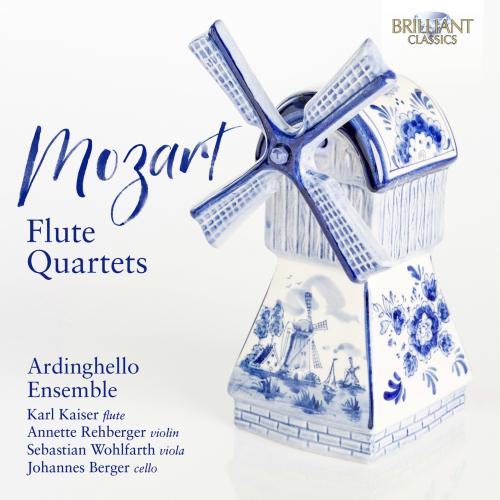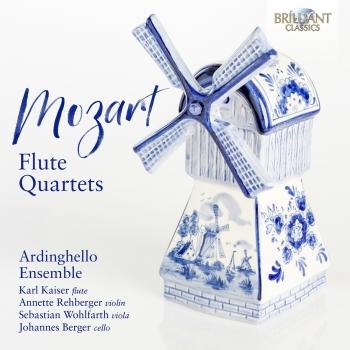
Mozart: Flute Quartets Ardinghello Ensemble
Album info
Album-Release:
2023
HRA-Release:
25.08.2023
Label: Brilliant Classics
Genre: Classical
Subgenre: Chamber Music
Artist: Ardinghello Ensemble
Composer: Wolfgang Amadeus Mozart (1756-1791)
Album including Album cover Booklet (PDF)
- Wolfgang Amadeus Mozart (1756 - 1791): Flute Quartet in D Major, K.285:
- 1 Mozart: Flute Quartet in D Major, K.285: I. Allegro 07:07
- 2 Mozart: Flute Quartet in D Major, K.285: II. Adagio 02:27
- 3 Mozart: Flute Quartet in D Major, K.285: III. Rondeau 04:45
- Flute Quartet in G Major, K.285a:
- 4 Mozart: Flute Quartet in G Major, K.285a: I. Andante 04:35
- 5 Mozart: Flute Quartet in G Major, K.285a: II. Tempo di Menuetto 03:11
- Flute Quartet in C Major, K.285b:
- 6 Mozart: Flute Quartet in C Major, K.285b: I. Allegro 05:41
- 7 Mozart: Flute Quartet in C Major, K.285b: II. Tema con variazioni (Andante - Adagio - Allegro) 09:32
- Flute Quartet in G Major, K.370:
- 8 Mozart: Flute Quartet in G Major, K.370: I. Allegro 06:38
- 9 Mozart: Flute Quartet in G Major, K.370: I. II. Adagio 02:47
- 10 Mozart: Flute Quartet in G Major, K.370: I. III. Rondo Allegro 04:57
- Flute Quartet in A Major, K.298:
- 11 Mozart: Flute Quartet in A Major, K.298: I. Tema (Andante) con Variazioni 05:59
- 12 Mozart: Flute Quartet in A Major, K.298: II. Menuetto/Trio 02:31
- 13 Mozart: Flute Quartet in A Major, K.298: III. Rondeau (Allegretto Grazioso) 02:54
Info for Mozart: Flute Quartets
Three of these marvellous quartets for flute and string trio were composed in 1777/78 during Mozart’s first extended tour without his father. The three quartets K. 285, 285a, 285b are undoubtedly among the most outstanding works in the genre. They share a lightsome, carefree quality with the typical shades of melancholy in the slow movements.
The sparkling Quartet in D K.285 is a virtuoso outing for all four instruments. Although the flute has the upper part in the lightning-fast opening concertante movement and the spirited concluding Rondeau, the string trio are also given strikingly brilliant, soloistic parts, creating a dense web of spirited, dazzling sallies and engagements. The central movement is a Romance with a melting flute melody against string pizzicatos – a sort of serenade with guitar accompaniment for his then love (future sister-in-law) Aloysia Weber, Constanze’s sister.
The elegant second Quartet in G K.285a is indebted to Johann Sebastian Bach’s youngest son, Johann Christian, who wrote quartets that were very similar in concept and idiom. At the age of eight Mozart had taken lessons with J.C. Bach while in London, and as late as 1778 he wrote: ‘I love him… with all my heart and feel deep respect for him’. Following the ‘London’ Bach’s example, the quartet comprises a substantial opening Andante in sonata form and a lively minuet.
The third Quartet in C K.285b is also in two movements. An effervescent movement in sonata form is followed by an elegant set of variations providing a solo variation for each of the four instruments. There follows a dreamy slow variation, before the music snaps back out of its metaphysical mood and into the here-and-now with a clownish minuet-cum-scherzo.
The Quartet in G K.370, though originally an oboe quartet in F, was first published in 1801 by the Bureau de Musique, Leipzig, in the G major arrangement for flute and strings. Transposing an oboe piece up a full tone was then common practice in flute adaptations, but in this instance,we are dealing with a genuine arrangement involving substantial modifications.
The Quartet in A K.298 is very different. It is of the Quatuor d’airs dialogués type, a popular Parisian form where each movement quotes an aria by a fellow composer or a tune that is widely known. The theme of the first movement is Franz Anton Hoffmeister’s song ‘An die Natur’. The central section of the ensuing minuet quotes the old French song ‘Il a des bottes, des bottes Bastien’. Finally, in the last movement, the theme is taken from Giovanni Paisiello’s opera Gli schiavi per amore. He used the aria ‘Chi mi mostra dolce amore’ (Who will show me sweet love) as the theme for the final movement.
This piece completes our cycle of five Mozart chamber works, taking us from Mannheim to Vienna via Munich. Their five different conceptions and characters represent the quartet for flute, violin, viola and cello in its noblest form and set the benchmark for all subsequent quartets composed for these forces.
Ardinghello Ensemble
Karl Kaiser, flute
Annette Rehberger, violin
Sebastian Wohlfarth, viola
Johannes Berger, cello
No biography found.
Booklet for Mozart: Flute Quartets












